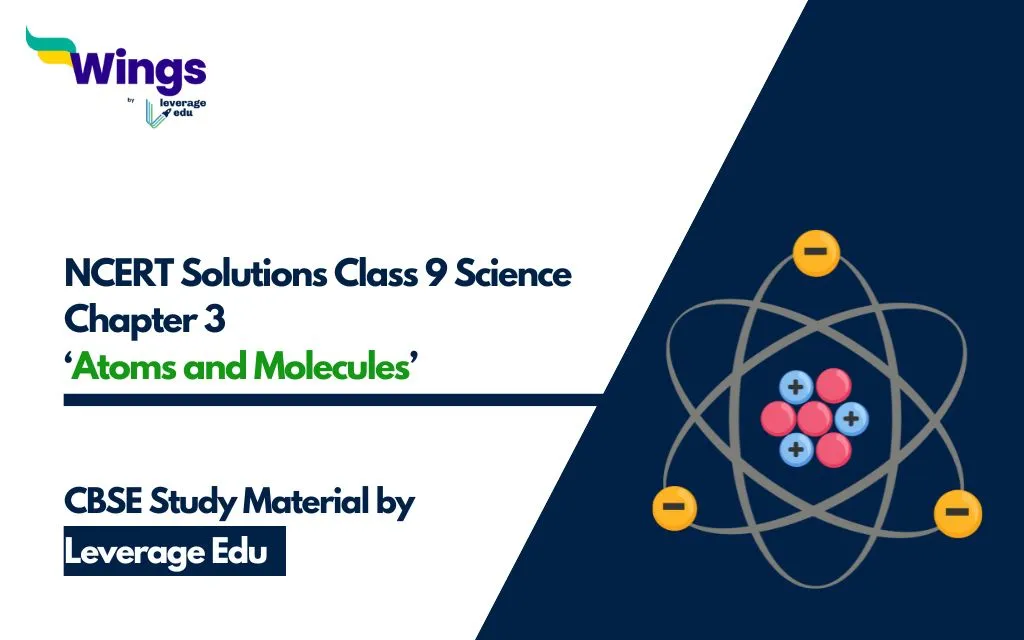We are providing NCERT Solutions Class 9 Science Chapter 3 ‘Atoms and Molecules’ to help you navigate through your school exams. You can also download a PDF for important questions and answers for quick revision. Let us get started!
Download the NCERT Solutions of Class 9 Science Chapter 3 PDF Here!
Download Solutions of all the Chapters of Class 9 Science:
| Chapter 1 | Chapter 2 | Chapter 3 | Chapter 4 | Chapter 5 | Chapter 6 |
| Chapter 7 | Chapter 8 | Chapter 9 | Chapter 10 | Chapter 11 | Chapter 12 |
NCERT Solutions Class 9 Science Chapter 3 Atoms and Molecules
Here are NCERT Solutions of Class 9 Science Chapter 3 ‘Atoms and Molecules’ to the questions in the exercise section of the lesson.
1. A 0.24g sample of a compound of oxygen and boron was found by analysis to contain 0.096g of boron and 0.144g of oxygen. Calculate the percentage composition of the compound by weight.
Solution:
Mass of the sample compound = 0.24g,
mass of boron = 0.096g, mass of oxygen = 0.144g
To calculate the percentage composition of the compound,
Percentage of boron = mass of boron / mass of the compound x 100
= 0.096g / 0.24g x 100 = 40%
Percentage of oxygen = 100 – percentage of boron
= 100 – 40 = 60%
2. When 3.0g of carbon is burnt in 8.00 g of oxygen, 11.00 g of carbon dioxide is produced. What mass of carbon dioxide will be formed when 3.00g of carbon is burnt in 50.00 g of oxygen? Which law of chemical combination will govern your answer?
Solution:
When 3.0 g of carbon is burnt in 8.00 g of oxygen, 11.00 g of carbon dioxide is produced.
3.0 g of carbon combines with 8.0 g of oxygen to give 11.0 of carbon dioxide.
C + O2 → CO2
As per the given condition, when 3.0 g of carbon is burnt in 8.00 g of oxygen, 11.00 g of carbon dioxide is produced.
3g + 8g →11 g ( from the above reaction)
The total mass of reactants = mass of carbon + mass of oxygen
=3g+8g
=11g
The total mass of reactants = Total mass of products
Hence, the law of conservation of mass is proved.
It depicts that carbon dioxide contains carbon and oxygen in a fixed ratio by mass, which is 3:8.
Thus, it further proves the law of constant proportions.
3 g of carbon must also combine with 8 g of oxygen only.
This means that (50−8)=42g of oxygen will remain unreacted.
The remaining 42 g of oxygen will be left un-reactive. In this case, too, only 11 g of carbon dioxide will be formed
The law of constant proportions governs the above answer.
3. What are polyatomic ions? Give examples.
Solution:
Ions that contain more than one atom, but behave as a single unit are known as polyatomic ions.
Example: CO32-, H2PO4–
4. Write the chemical formula of the following.
(a) Magnesium chloride
(b) Calcium oxide
(c) Copper nitrate
(d) Aluminium chloride
(e) Calcium carbonate
Solution:
(a) Magnesium chloride – MgCl2
(b) Calcium oxide – CaO
(c) Copper nitrate – Cu(NO3)2
(d) Aluminium chloride – AlCl3
(e) Calcium carbonate – CaCO3
5. Give the names of the elements present in the following compounds.
(a) Quick lime
(b) Hydrogen bromide
(c) Baking powder
(d) Potassium sulphate
Solution:
(a) Quick lime – Calcium and oxygen (CaO)
(b) Hydrogen bromide – Hydrogen and bromine (HBr)
(c) Baking powder – Sodium, Carbon, Hydrogen, Oxygen (NaHCO3)
(d) Potassium sulphate – Sulphur, Oxygen, Potassium (K2SO4)
6. Calculate the molar mass of the following substances.
(a) Ethyne, C2H2
(b) Sulphur molecule, S8
(c) Phosphorus molecule, P4 (Atomic mass of phosphorus =31)
(d) Hydrochloric acid, HCl
(e) Nitric acid, HNO3
Solution:
(a) Molar mass of Ethyne C2H2= 2 x Mass of C+2 x Mass of H = (2×12)+(2×1)=24+2=26g
(b) Molar mass of Sulphur molecule S8 = 8 x Mass of S = 8 x 32 = 256g
(c) Molar mass of Phosphorus molecule, P4 = 4 x Mass of P = 4 x 31 = 124g
(d) Molar mass of Hydrochloric acid, HCl = Mass of H+ Mass of Cl = 1+35.5 = 36.5g
(e) Molar mass of Nitric acid, HNO3 =Mass of H+ Mass of Nitrogen + 3 x Mass of O = 1 + 14+3×16 = 63g
Download the NCERT Solutions of Class 9 Science Chapter 3 PDF Here!
Download Solutions of all the Chapters of Class 9 Science:
| Chapter 1 | Chapter 2 | Chapter 3 | Chapter 4 | Chapter 5 | Chapter 6 |
| Chapter 7 | Chapter 8 | Chapter 9 | Chapter 10 | Chapter 11 | Chapter 12 |
Related Reads:
Explore Notes of All subjects of CBSE Class 9:
| CBSE Notes Class 9 English | CBSE Notes Class 9 History | CBSE Notes Class 9 Geography |
| CBSE Notes Class 9 Civics | CBSE Notes Class 9 Mathematics | CBSE Notes Class 9 Science |
FAQs
The smallest unit of matter or any element that exhibits its properties is known as an atom.
The ability of an atom or the combining power of an atom to for bonds with other atoms is called valency.
The full form of amu is “Atomic Mass Unit”.
Follow Leverage Edu for complete study material on CBSE Notes of Class 9 Science.
 One app for all your study abroad needs
One app for all your study abroad needs














